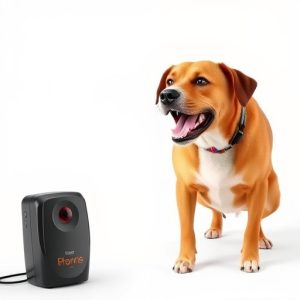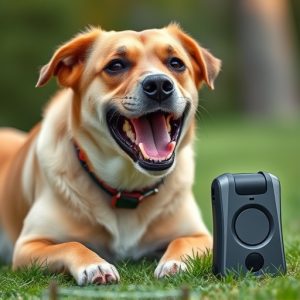Handheld Sonic Dog Deterrents: Effectiveness & Responsible Use
Handheld sonic dog deterrents, emitting high-frequency sound waves, offer a non-lethal method for ma…….
Handheld sonic dog deterrents, emitting high-frequency sound waves, offer a non-lethal method for managing canine behavior in public spaces. Their effectiveness depends on factors like decibel level, dog sensitivity, and environmental conditions. While successful with some dogs and users, others may show little response due to inconsistent usage or breed differences. Responsible usage involves adjusting settings based on terrain, weather, and respecting neighbors' privacy while adhering to local noise regulations. These devices provide a safe, innovative approach for neighborhood dog control, but success requires consideration of device range, frequency, and consistent training.
Neighborhood dog control has become a pressing issue, with noise complaints rising. This article explores handheld sonic dog deterrents as a potential solution. We’ll delve into how these devices work, their effectiveness in controlling canine behavior, and the factors influencing their success. Learn about responsible usage, alternative methods, and considerations for implementing these innovative tools to ensure their maximum efficiency and ethical application. Discover the impact on your community with this modern approach to dog control.
- Understanding Handheld Sonic Dog Deterrents
- How Effective Are These Devices?
- Factors Influencing Their Success
- Using Sonic Equipment Responsibly
- Alternatives and Considerations
Understanding Handheld Sonic Dog Deterrents
Handheld sonic dog deterrents have gained popularity as a non-lethal method to control canine behavior in public spaces. These devices emit high-frequency sound waves that are designed to disrupt and disorient dogs, encouraging them to leave the area. The effectiveness of these tools lies in their ability to target specific behaviors, such as barking or aggressive posturing, without causing harm to the animals.
The handheld nature allows for easy deployment and control, making it a practical solution for park managers, security personnel, and pet owners. However, the success of this approach depends on various factors, including the device’s decibel level, the dog’s sensitivity to sound, and environmental conditions. Studies have shown mixed results regarding their long-term effectiveness, with some dogs becoming accustomed to the noise over time. Thus, it’s crucial to understand both the strengths and limitations of these devices for responsible and effective usage.
How Effective Are These Devices?
The effectiveness of handheld sonic dog deterrents has been a topic of interest for many pet owners and communities struggling with unwanted canine behavior. These devices emit high-frequency sound waves that are designed to disrupt and discourage dogs from barking or intruding into specific areas. While some users report significant improvements, the overall success varies greatly.
Studies on handheld sonic dog deterrents show mixed results. Certain breeds, especially those with exceptional hearing like Chihuahuas, can be more responsive to the sound signals. However, for larger breeds and those less sensitive to high frequencies, the devices may have little to no effect. Moreover, consistent usage is key; intermittent use might not train dogs to associate the sound with negative consequences, rendering the deterrent less effective over time.
Factors Influencing Their Success
The effectiveness of handheld sonic dog deterrents depends on several key factors. One major consideration is the device’s frequency range and sound intensity. These devices emit high-frequency sounds that are unpleasant to dogs, but it’s crucial that they fall within an audible range for maximum impact. Devices with adjustable settings allow users to tailor the sound level to different environments, ensuring it’s loud enough to deter dogs without being excessively disturbing to humans or other pets.
Another influencing factor is the specific behavior and temperament of the dog. Younger or more aggressive dogs might require higher sound intensities or longer exposure times to be effectively deterred. Additionally, training and environmental context play a role; consistent use of the device in specific areas where dogs are prone to bother residents can reinforce its effectiveness as a deterrent over time.
Using Sonic Equipment Responsibly
Using handheld sonic dog deterrents responsibly is paramount to ensure their effectiveness and safety. These devices emit high-frequency sound waves that are typically inaudible to humans but can startle dogs, encouraging them to leave the area. To maximize results, users should familiarize themselves with the equipment’s settings and adjust as needed based on environmental factors. For instance, different terrains and weather conditions may affect sound propagation.
It’s crucial to employ these devices humanely and only in designated areas. Responsible use involves avoiding excessive activation, as constant exposure could potentially harm dogs’ hearing or cause stress. Additionally, users should respect the privacy of neighbors and avoid using such equipment near homes with small children or sensitive pets. Always follow local regulations regarding noise levels and restrictions on the use of dog deterrents to maintain harmonious relationships within the community.
Alternatives and Considerations
When considering neighborhood dog control, it’s crucial to explore a range of options beyond traditional methods. One innovative approach gaining traction is the use of handheld sonic dog deterrents. These devices emit high-frequency sound waves that are unpleasant to dogs but harmless to humans and other animals. The effectiveness of this method lies in its non-lethal nature and ability to train dogs without causing them harm, making it a popular choice for pet owners and community members alike.
However, the success of handheld sonic deterrents depends on several factors. Range and frequency are key; devices should be able to reach the intended area and emit sounds within the auditory range that disrupts dogs but remains inaudible to humans. Additionally, consistency of use is essential. Like any training method, repeated exposure to the sonic deterrent helps reinforce the message to stray or unruly dogs. Always consider the well-being of local wildlife and ensure the device is used responsibly, as not all environments or dog behaviors respond equally to this technology.
Handheld sonic dog deterrents can be an effective tool for managing canine behavior in public spaces, but their success depends on various factors. While these devices emit high-frequency sounds that disrupt dogs’ communication and potentially discourage unwanted behaviors, their effectiveness varies based on the device’s quality, environmental conditions, and the training of both the dog and its owner. Responsible use involves understanding the limitations and ensuring the well-being of both pets and people. Consider alternative methods or combine these tools with positive reinforcement training for optimal results in addressing neighborhood dog control issues.


